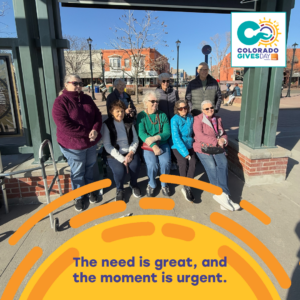BOULDER, Colo. (KDVR) – They’re used to fighting on the front lines. But for a group of Colorado veterans, this is a different kind of war. Read more
Now that masks are recommended for everyone who’s out and about, new questions are coming in from Colorado Wonders and other channels about mask etiquette and efficacy. Read more
WESTMINSTER, Colo. (KDVR) — Vietnam War veteran Joe Duran, 70, spent Friday rallying support for health care workers outside the St. Anthony North Health Campus at West 144th Avenue and Delaware Street. Read more
Four more Denver street segments will close to cars, for the most part, the city government announced Thursday. Read more
Attendance: Teague Kirkpatrick, Route Match, Sarah Grant, City/County of Broomfield (CCB), Marc Ambrosi, CCB, Lisa Bitzner, Via Mobility, Kate Williams, DRMAC/RTD, Bob Davis, Citizen Advocate
Sarah will type up the minutes of the February meeting and send to LCC members. Jen Hussey of Broomfield Easy Ride was unable to join the meeting as she had another meeting same time.
The group went around and shared information. Sarah spoke for Easy Ride – they are now doing only medical and grocery trips although they have added special runs for early morning Hours for older adults at the local grocery. CCB has added the Access A Ride food runs on their web site. There will not be Mobility Days in May, as in years past. The event, along with others, will be rescheduled for later in the year. CCB has furloughed 250 employees as of this week and has a bleak outlook on the sales tax income.
Lisa advised that Via Mobility has asked their volunteer drivers to stay home and furloughed some of their paid drivers. They have about 12 drivers still working along with some senior staff working from home – they have 2 people in the call center scheduling rides mostly for medical and groceries. They have been doing dialysis trips and have picked up some folks who used to use American Cancer, which has stopped providing service, and is taking those people to chemo appointments. They have waived all fares.
Kate reported on RTD service reductions upcoming, the added cars on trains to help with social distancing, all service fare free, rear door boarding, and the struggle at RTD to balance safety with employee needs and rider needs. Revenue is going to be an issue even with federal aid. DRMAC staff is working hard to keep current with all area providers on their special live transit feed, and continues to participate in area LCCs, along with a variety of task forces and committees that are meeting virtually.
Marc reported that he is working on contracts with both CDOT and RTD; CCB may apply for 5310 funds from DRCOG for the first time.
Teague reported that he is hearing the same stories throughout the nation from the transit agencies of all sizes and locations that he works with.
The group agreed to meet again virtually in May; Teague will send out an invite, and Bob Davis will work on his microphone!
CDOT Monthly Transit Providers meeting
The agenda was:
- Team CDOT-business office, audit, civil rights (CRBRC), procurement Office
- Special guest- Mallory Cyr, CO HCPF- NEMT Update
- All that, and a bag of chips- updates Dolores County…
- Team DTR- Bustang/outrider
- CASTA & RTAP- Updates and information
- Topic of Concern-CO Transit and COVID-19 Information and discussion
NEMT- Non-Emergency Medical Transportation
3 ways it is used:
- By each county’s human services
- Multi-county collaboratives
- State contracted broker for 9 front range counties (intelliride)
Plan and purpose are set for July 1st to expand broker model across the state instead of only the 9 front range counties.
RFP is completed and is now in negotiations.
This means it will improve programs and access for members. Its different everywhere and many don’t know about the option of NEMT.
The benefits are not changing or going away.
For more information go to: www.Colorado.gov/pacific/hcpf/non-emergency-medical-transportation
or email questions to: NEMT@state.co.us
DTR-Bustang- will be down till April 26th New routes to come 2021!!!
Greyhound still running
CASTA- Spring training conference cancelled.
Current transportation providers position and order of operations
| Status | Percent | Numbers |
| Normal | 3% | 2 |
| Reduced | 66% | 53 |
| Suspended | 31% | 25 |
![DRMAClogo[1] DRMAC](https://drmac-co.org/wp-content/uploads/2019/12/DRMAC20logo1.jpg)





